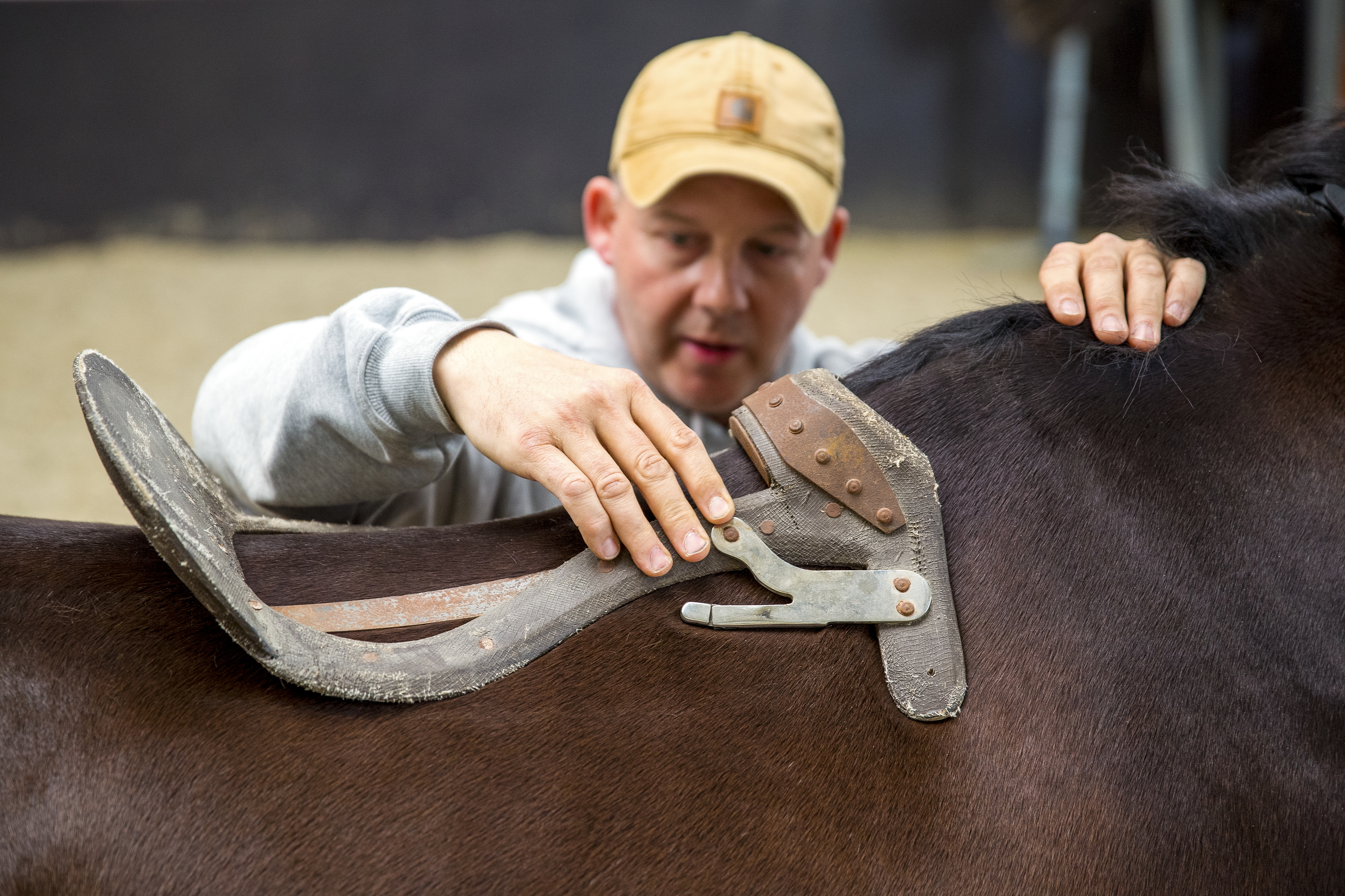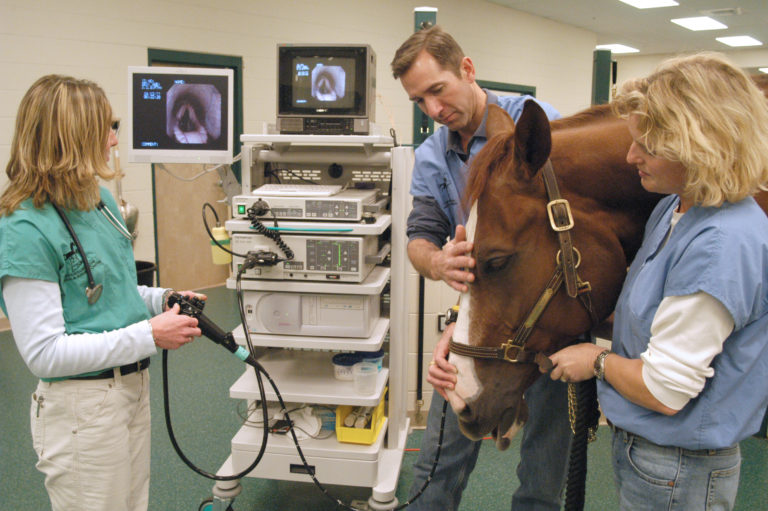Q: My horse’s left side is less developed than his right side. What are important saddle-fitting considerations to allow an underdeveloped side to develop? Would you want to keep the panels perfectly symmetrical and evenly stuffed or would you put more stuffing on the underdeveloped side?
—Amanda Norris of Garland, Texas
A: Your questions seem simple enough. However, there are many factors to consider before I can attempt to answer you. I would need to gather a bit more information from you to best help you with your issue. I would first explore your partnership with your horse. I would begin by asking you some questions: How old is your horse and where is he in his work? How often is the horse ridden? Do you do most of the riding or is your horse ridden by a professional? Are you a pleasure rider or a competitive rider? Has the horse had anything that has caused his left side to be weaker (for instance, an injury)?
The reasons for asymmetry are injury and lack of straightness through training. One has to determine the root of why the horse has developed this issue. Sometimes, it has less to do with the shoulder and more to do with a particular area across the horse’s back. For example, a large left shoulder is indicative of a weak right hind (or the opposite). It is normally a weak hind leg that is not stepping through. In this case, the muscle under the rider’s right seat bone does not develop due to the rider’s weight not being carried equally.
These are important questions in my assessment as saddle fit is not always straightforward. Since this is not possible, I will make the assumption that your horse is correctly ridden a few days a week and he is a fairly young horse with no medical issues keeping him from properly developing.

Correct saddle placement, balance and stability are all required for proper saddle fit. The saddle must also always remain parallel to the horse’s body and not fall into the skin when you are seated on the horse, particularly on circles. A saddle that presses into the horse’s skin, disrupts the blood flow to the healthy tissue of the back, and soreness or damage to the tissue can occur. You want the saddle to sit on top of the skin as if it were a piece of paper stacked on top of another. When you ride a circle, the saddle should stay balanced and mirror the horse’s movement.
To conduct your own evaluation, first, I would assess your horse’s conformation and check his back for any soreness or sensitive areas. Next, I would address your saddle. I would inspect the saddle, making sure everything looks as it should (the panels are straight and even), then examine its overall condition as well as the condition of the panels and billets. I would be looking for obvious details that could negatively impact your horse, such as lumpy flocking or hard spots that can be felt through the panel. Next, I would place the saddle directly on your horse’s back (no padding) about two finger-widths behind the scapula. Assess how the saddle looks. Is the saddle lower in the pommel or the cantle? It should be level front to back, so if you were to roll a pen down the saddle, the pen would stop in the middle, which would confirm that the saddle is balanced. This is where the floor of the seat sits, in the deepest part of the saddle. The reason why this is important is that if the balance is not even on the horse’s back, the blood flow to the his muscles will be interrupted and you will not get proper development of the weaker side. I would then assess if there is any pressure where the saddle makes contact with the horse’s body. You may need the help of a knowledgeable saddle-fitter to check this. I would want to make sure the saddle is sufficiently wide enough that the panels allow the spinal column to be free of any contact with the saddle. When the rider is seated in the saddle and the horse is working through his paces, it is important for the saddle to allow the horse to move his body without restriction.
Next, we should address stability. There are several reasons why a saddle might not be stable. For example, the saddle tree is the basic support structure that the saddle is manufactured around. It must be the correct shape for the horse and mirror his body. If the horse has a flat back, the tree must be flat. If the horse has a curve in his spine, the tree must follow that shape. If you ignore this detail, the saddle fit will always be compromised and you could get some saddle movement or soreness across the horse’s back. I like to say that saddles are to horses as shoes are to us. I would not want to run a marathon in a tight shoe or high heels.
If the horse has some weakness or atrophy from an injury or poor-fitting equipment, the first course of action is to address the saddle fit as I have explained. If all checks out as I have outlined, we can start to address your question.
The panels of the saddle are there to support and distribute the body weight of the rider. They have a relationship to the horse in terms of shape, size, length and thickness, and to the rider’s weight. No horse or rider is completely symmetrical. Therefore, two panels that are identical at the beginning will change over time. The rider has a responsibility to ride the horse correctly. It is the rider’s influence that strengthens the horse’s weaknesses so he becomes straight and through. The rider’s fitness will be a factor to accomplish this task. If I have a horse with the type of issue you describe, I will suggest that I see that horse more often and take measurements to monitor the progress in the muscle development.
Sometimes stability becomes an issue when the horse is asymmetrical. The saddle may fall toward the horse’s weakness or, by making an effort to correct the horse, the rider unconsciously falls into the horse’s weaker side. We want to avoid this as best as we can. This is another reason to have regular maintenance appointments with your saddle-fitter. As saddle-fitters, we strive to give the horse every benefit to get stronger. If at all possible, we do not want to keep stuffing a panel on the horse’s less-dominant side. First of all, the wool alone will not be able to support the rider without putting uneven pressure on the horse’s back. Secondly, the wool will not be firm enough to hold up the rider against the undeveloped muscle. Sometimes, shimming a saddle is the best solution. As a saddle-fitter, often this becomes a lesson in creativity. We always prefer shimming as it allows the fitter to keep the rider in complete balance on the circle, allowing the horse’s muscle to develop under the rider’s seat. It is easier to remove a shim as the horse’s musculature develops due to not being pressured.
Resolving saddle fit can be challenging but well worth the effort. Everything we do to help maintain our four-legged friend has an effect that can change saddle fit. Your feeding program, farrier, equine dentist, veterinarian, instructor and you all play a roll in the progress of your horse. I encourage you to continue to seek out a qualified saddle-fitter to help you and your horse reach your goals, whatever they may be.
Diane Sasscer is an independent saddle-fitter who has been fitting saddles for 18 years. Her clients include Olympic team riders from the U.S. and other countries as well as local horse enthusiasts. She is based in Wellington, Florida. (Saddlefitbydiane.com).
This article first appeared in the June 2017 issue of Dressage Today.











